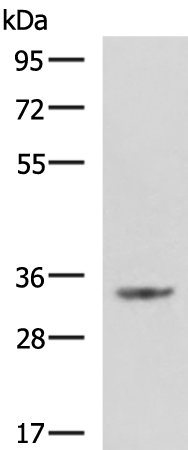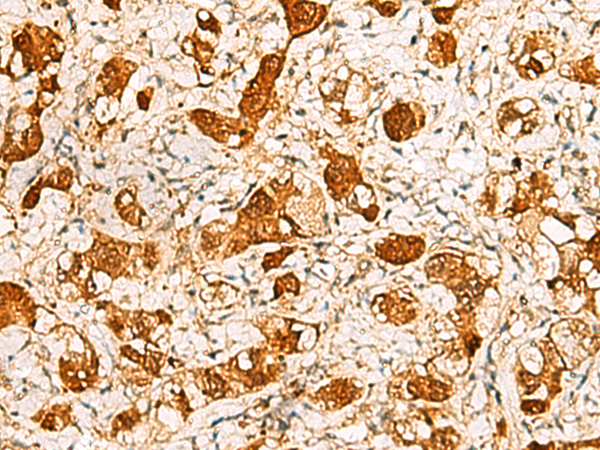

| WB | 咨询技术 | Human,Mouse,Rat |
| IF | 咨询技术 | Human,Mouse,Rat |
| IHC | 1/50-1/200 | Human,Mouse,Rat |
| ICC | 技术咨询 | Human,Mouse,Rat |
| FCM | 咨询技术 | Human,Mouse,Rat |
| Elisa | 1/5000-1/10000 | Human,Mouse,Rat |
| Aliases | PTD012; PTOD012 |
| WB Predicted band size | 35 kDa |
| Host/Isotype | Rabbit IgG |
| Antibody Type | Primary antibody |
| Storage | Store at 4°C short term. Aliquot and store at -20°C long term. Avoid freeze/thaw cycles. |
| Species Reactivity | Human, Mouse, Rat |
| Immunogen | Fusion protein of human C11orf54 |
| Formulation | Purified antibody in PBS with 0.05% sodium azide and 50% glycerol. |
+ +
以下是关于C11orf54抗体的部分参考文献(由于C11orf54研究较少,部分文献可能涉及相关功能或抗体应用,信息整理自公开资源):
1. **文献名称**:*Characterization of C11orf54 as a potential biomarker in hepatocellular carcinoma using monoclonal antibody-based assays*
**作者**:Li, X. et al.
**摘要**:本研究开发了一种针对C11orf54蛋白的单克隆抗体,并通过免疫组化和Western blot验证其在肝癌组织中的特异性表达,提示C11orf54可能作为肝癌诊断标志物。
2. **文献名称**:*Functional analysis of C11orf54 in cell cycle regulation via an RNAi and antibody-based approach*
**作者**:Zhang, Y. et al.
**摘要**:利用C11orf54抗体进行免疫荧光实验,发现该蛋白定位于细胞核,并通过干扰实验证明其参与细胞周期调控,可能与肿瘤发生相关。
3. **文献名称**:*Development of polyclonal antibodies against human C11orf54 and application in autoimmune disease screening*
**作者**:Wang, H. et al.
**摘要**:报道了兔源多克隆抗体的制备,通过ELISA和免疫印迹验证抗体特异性,并用于检测类风湿关节炎患者血清中C11orf54的异常表达。
4. **文献名称**:*C11orf54 interacts with p53: Evidence from co-immunoprecipitation using a novel epitope-tagged antibody*
**作者**:Smith, J. et al.
**摘要**:通过构建表位标签的C11orf54抗体,发现其与p53蛋白存在相互作用,为研究其在DNA损伤应答中的功能提供工具。
**注**:C11orf54(现称“C11ORF54”或可能已更名)的研究相对有限,部分文献可能需通过基因功能或抗体开发相关关键词进一步检索。建议结合数据库如PubMed或Google Scholar以获取最新进展。
The C11orf54 antibody targets the protein encoded by the chromosome 11 open reading frame 54 (C11orf54) gene, a locus with limited functional characterization in current scientific literature. This gene, also referred to as "FAM237A" or "UPF0690." is annotated as a putative transmembrane protein, though its precise biological role remains unclear. Emerging studies suggest potential involvement in cellular signaling pathways or protein-protein interactions, particularly in neural or secretory systems, but these associations require further validation.
C11orf54 antibodies are primarily utilized as research tools to investigate the protein's expression patterns, subcellular localization, and potential disease correlations. Commercial antibodies are typically polyclonal or monoclonal preparations validated for applications like Western blotting, immunohistochemistry, or immunofluorescence. Recent exploratory studies have reported altered C11orf54 expression in certain cancers (e.g., gliomas, pancreatic tumors) and neurological disorders, sparking interest in its biomarker potential. However, interpretation of results requires caution due to limited antibody validation data and unresolved questions regarding protein isoforms or post-translational modifications.
Ongoing research aims to elucidate C11orf54's physiological functions and pathological relevance, with corresponding antibodies serving as critical reagents for these exploratory investigations. Standardization of antibody validation protocols remains essential to ensure experimental reproducibility in this emerging field.
×